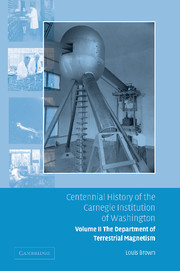Book contents
- Frontmatter
- Contents
- Foreword by Richard A. Meserve
- Preface
- 1 Establishment
- 2 Cruises and war
- 3 Expeditions
- 4 Measurements: magnetic and electric
- 5 The Fleming transition
- 6 The last cruise
- 7 The magnetic observatories and final land observations
- 8 The ionosphere
- 9 Collaboration and evaluation
- 10 The Tesla coil
- 11 The Van de Graaff accelerator
- 12 The nuclear force
- 13 Fission
- 14 Cosmic rays
- 15 The proximity fuze and the war effort
- 16 The Tuve transition
- 17 Postwar nuclear physics
- 18 The cyclotron
- 19 Biophysics
- 20 Explosion seismology
- 21 Isotope geology
- 22 Radio astronomy
- 23 Image tubes
- 24 Computers
- 25 Earthquake seismology
- 26 Strainmeters
- 27 The Bolton and Wetherill years
- 28 Astronomy
- 29 The solar system
- 30 Geochemistry
- 31 Island-arc volcanoes
- 32 Seismology revisited
- 33 Geochemistry and cosmochemistry
- 34 The Solomon transition
- 35 The support staff
- 36 Epilogue
- Notes
- Index
7 - The magnetic observatories and final land observations
Published online by Cambridge University Press: 06 January 2010
- Frontmatter
- Contents
- Foreword by Richard A. Meserve
- Preface
- 1 Establishment
- 2 Cruises and war
- 3 Expeditions
- 4 Measurements: magnetic and electric
- 5 The Fleming transition
- 6 The last cruise
- 7 The magnetic observatories and final land observations
- 8 The ionosphere
- 9 Collaboration and evaluation
- 10 The Tesla coil
- 11 The Van de Graaff accelerator
- 12 The nuclear force
- 13 Fission
- 14 Cosmic rays
- 15 The proximity fuze and the war effort
- 16 The Tuve transition
- 17 Postwar nuclear physics
- 18 The cyclotron
- 19 Biophysics
- 20 Explosion seismology
- 21 Isotope geology
- 22 Radio astronomy
- 23 Image tubes
- 24 Computers
- 25 Earthquake seismology
- 26 Strainmeters
- 27 The Bolton and Wetherill years
- 28 Astronomy
- 29 The solar system
- 30 Geochemistry
- 31 Island-arc volcanoes
- 32 Seismology revisited
- 33 Geochemistry and cosmochemistry
- 34 The Solomon transition
- 35 The support staff
- 36 Epilogue
- Notes
- Index
Summary
When the Department's world magnetic survey began there were in operation a number of magnetic observatories, the limited method by which individual nations or organizations approached the study of the geomagnetic field. Tied as they frequently were as the cultural appendages of nations of the northern hemisphere, they provided a limited picture of matters, despite the high quality of their data. Bauer's cruises and expeditions expanded this meager set of data into a global picture. Nevertheless, observatories gave extremely valuable information about the temporal variation of the field, both the diurnal and secular variations as well as the enigmatic magnetic storms. Of particular value for interpreting events were recordings of any kind of temporal change taken simultaneously worldwide.
In 1915 the Department set out to correct the severe imbalance in the distribution of observatories by establishing two in the southern hemisphere. In addition to magnetic measurements they were to study (1) variation in the fair-weather electric potential and conductivity of the air; (2) earth currents and their relationship to the geomagnetic field; (3) cosmic rays and their relationship to magnetic data; and (4) disturbances of the Sun's chromosphere. The general regions selected were the southwestern part of Australia and the Peruvian Andes. The former was selected to fill a gap between observatories at the same latitude at Melbourne and Mauritius (Indian Ocean); the latter because it would lie near the geomagnetic equator.
- Type
- Chapter
- Information
- Publisher: Cambridge University PressPrint publication year: 2005



